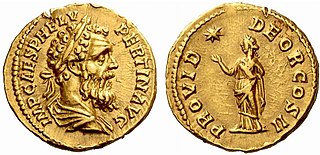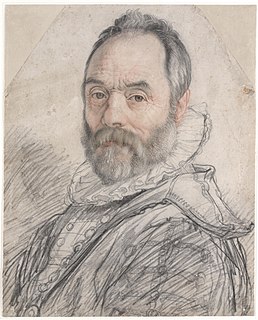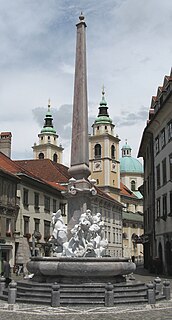
Rococo, less commonly Roccoco or Late Baroque, is an exceptionally ornamental and theatrical style of architecture, art and decoration which combines asymmetry, scrolling curves, gilding, white and pastel colours, sculpted moulding, and trompe-l'œil frescoes to create surprise and the illusion of motion and drama. It is often described as the final expression of the Baroque movement.

In ancient Roman religion, Providentia is a divine personification of the ability to foresee and make provision. She was among the embodiments of virtues that were part of the Imperial cult of ancient Rome. Providentia thus figures in art, cult, and literature, but has little or no mythology as such.

Giambologna, also known as Jean de Boulogne (French), Jehan Boulongne (Flemish) and Giovanni da Bologna (Italian), was the last significant Italian Renaissance sculptor, with a large workshop producing large and small works in bronze and marble in a late Mannerist style.

Baroque architecture is a highly decorative and theatrical style which appeared in Italy in the early 17th century and gradually spread across Europe. It was originally introduced by the Catholic Church, particularly by the Jesuits, as a means to combat the Reformation and the Protestant church with a new architecture that inspired surprise and awe. It reached its peak in the High Baroque (1625–1675), when it was used in churches and palaces in Italy, Spain, Portugal, France, Bavaria and Austria. In the Late Baroque period (1675–1750), it reached as far as Russia and the Spanish and Portuguese colonies in Latin America. About 1730, an even more elaborately decorative variant called Rococo appeared and flourished in Central Europe.

Johann Balthasar Neumann, usually known as Balthasar Neumann, was a German architect and military artillery engineer who developed a refined brand of Baroque architecture, fusing Austrian, Bohemian, Italian, and French elements to design some of the most impressive buildings of the period, including the Würzburg Residence and the Basilica of the Fourteen Holy Helpers.

Johann Bernhard Fischer von Erlach was an Austrian architect, sculptor, engraver, and architectural historian whose Baroque architecture profoundly influenced and shaped the tastes of the Habsburg Empire. His influential book A Plan of Civil and Historical Architecture (1721) was one of the first and most popular comparative studies of world architecture. His major works include Schönbrunn Palace, Karlskirche, and the Austrian National Library in Vienna, and Schloss Klessheim, Holy Trinity Church, and the Kollegienkirche in Salzburg.

The Episcopal Summer Palace is the former residence of the archbishop of Pozsony.

Edmé Bouchardon was a French sculptor best known for his neoclassical statues in the gardens of the Palace of Versailles, his medals, his equestrian statue of Louis XV of France for the Place de la Concorde ; and for the Fountain of Four Seasons in Paris. He was also a draftsman and painter, and made celebrated series of engravings of working-class Parisians.

Balthasar Ferdinand Moll was one of the most famous sculptors in Vienna during the height of the Baroque era

Balthasar Permoser was among the leading sculptors of his generation, whose evolving working styles spanned the late Baroque and early Rococo.

Antonio Corradini was an Italian Rococo sculptor from Venice. He is best known for his illusory veiled depictions of human body, where the contours of the face and bodies beneath the veil are discernible.

Matthias Steinl was an Austrian painter, architect and designer, and one of the country's best known Baroque sculptors. Together with Johann Bernhard Fischer von Erlach (1656–1723) and his rival Johann Lukas von Hildebrandt (1668–1765), Steinl may be considered one of the most influential architects to introduce the High Baroque style to Austria.

Johann-Georg Bendl(Czech pronunciation: [ˈjohaŋ ˈɡɛorɡ ˈbɛndl̩]) or Jan Jiří Bendl was a Baroque sculptor, who worked mainly in Prague.

Ignaz Bendl was a Bohemian painter, sculptor, medalist, and ivory engraver, who worked mainly in Vienna and Brno.

Pietro Bracci (1700–1773) was an Italian sculptor working in the Late Baroque manner.

Lorenzo Mattielli was an Italian sculptor from the Late Baroque period. His name has also variously been written as Matielli, Mattiely, Matthielli, and Mathielli. He supplied statuary for palaces and churches in Vienna and Dresden and for the monastery of Melk (Austria).

Baroque sculpture is the sculpture associated with the Baroque style of the period between the early 17th and mid 18th centuries. In Baroque sculpture, groups of figures assumed new importance, and there was a dynamic movement and energy of human forms—they spiralled around an empty central vortex, or reached outwards into the surrounding space. Baroque sculpture often had multiple ideal viewing angles, and reflected a general continuation of the Renaissance move away from the relief to sculpture created in the round, and designed to be placed in the middle of a large space—elaborate fountains such as Gian Lorenzo Bernini‘s Fontana dei Quattro Fiumi, or those in the Gardens of Versailles were a Baroque speciality. The Baroque style was perfectly suited to sculpture, with Bernini the dominating figure of the age in works such as The Ecstasy of St Theresa (1647–1652). Much Baroque sculpture added extra-sculptural elements, for example, concealed lighting, or water fountains, or fused sculpture and architecture to create a transformative experience for the viewer. Artists saw themselves as in the classical tradition, but admired Hellenistic and later Roman sculpture, rather than that of the more "Classical" periods as they are seen today.

Francesco Robba was an Italian sculptor of the Baroque period. Even though he is regarded as the leading Baroque sculptor of marble statuary in southeastern Central Europe, he has remained practically unknown to international scholars.

¨Johan Christoph Petzold was a German sculptor who mainly worked in Denmark. He was a professor at the Royal Danish Academy of Fine Arts from its establishment in 1754 and briefly held the post of Sculptor to the Danish Court.
Erica Tietze-Conrat (née Erika Conrat, also known as Erica Tietze; born June 20, 1883 – died December 12, 1958) was an Austrian-born American art historian, one of the first women to study art history, a strong supporter of contemporary art in Vienna and an art historian specializing in Renaissance art and the Venetian school drawings.




















